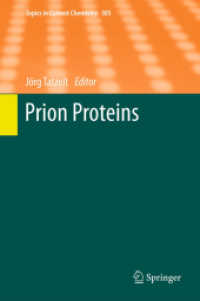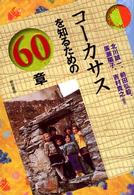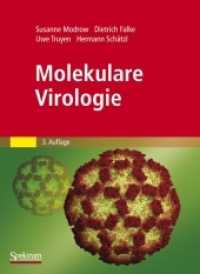- ホーム
- > 洋書
- > 英文書
- > Nature / Ecology
Full Description
This edited book is focused on Sustainable Development Goal 2, which aims to achieve 'Zero Hunger.' It provides deep insights into the global sorghum status, limitations to its production, advancements in agronomic practices, and the application of high-throughput phenotyping technologies.
Sorghum plays a vital role in global food security, agricultural sustainability, and rural livelihoods, making it an important crop for both developing and developed countries. It is a staple food for millions of people around the world, particularly in arid and semi-arid regions where other crops may struggle to grow. Sorghum exhibits significant genetic diversity, providing a rich resource for breeding programs aimed at developing improved varieties with traits such as higher yield, disease resistance, and nutritional quality. The book enhances readers' understanding of classical breeding methods and their role in sorghum improvement. It also focuses on the contribution of OMICs and biotechnological approaches to sorghum improvement. Detailed information about the genetic and genomic resources of sorghum provided is helpful for the scientific community to utilize in sorghum breeding. Chapters highlight sorghum genome sequencing, transgenic and hybrid sorghum, and the application of genome editing.
This book is useful to the breeding community, serving as a resource for interdisciplinary research groups such as geneticists, breeders, biotechnologists, bioinformaticians, and students, supporting them in accelerating their activities related to sorghum breeding.
Contents
Chapter 1. Trends in Global Sorghum Production: Perspectives and Limitations.- Chapter 2. Agronomic Practices for Sorghum Production.- Chapter 3. Adaptability and Cultivation of Sorghum under Climate Change Scenarios.- Chapter 4. Advancing Sorghum Improvement through High Throughput Phenotyping Technologies.- Chapter 5. Sorghum Potential for Nutrition and Food Security.- Chapter 6. Crop Wild Relatives of Sorghum as a Novel Source Variation for Crop Improvement.- Chapter 7. Hybrid Sorghum Production: Considerations according to Breeder and End-User.- Chapter 8. Breeding Techniques for the Major Sorghum Market Segments: Grain, Forage, Biomass and Soluble Sugars.- Chapter 9. Photoperiod and Temperature Sensitivity in Sorghum.- Chapter 10. Status of Sorghum Breeding in Asia.- Chapter 11. Breeding Advancements of Sorghum in Europe.- Chapter 12. Marker-Assisted Breeding in Major Insect Pest of Sorghum Crop.- Chapter 13. Mitigating Abiotic Stress through the Application of Genomic and Breeding Strategies in Sorghum.- Chapter 14. OMICs Approaches for Improving Sorghum Value Chains.- Chapter 15. New Breeding Trends in Sorghum.- Chapter 16. Future Strategies for Sorghum Improvement under Climate Change Scenario.- Chapter 17. Summary of the Potential and Exploitation of Omics and Biotechnological Breakthroughs in Sorghum.- Chapter 18. Sorghum Environment Characterization and G x M Modelling Toolbox.








